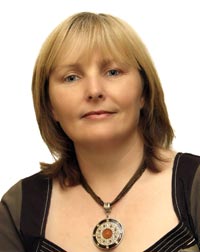10 December 2009 Edition
Irish and proud

Críona Ní Dhálaigh
BY ELLA O’DWYER
SINN FÉIN Councillor Críona Ní Dhálaigh has been instrumental in having a council motion passed last Wednesday week at the Dublin City Development Plan meeting to have new housing developments in the city named in the Irish language.
The motion was put to the council by Ní Dhálaigh; Fianna Fáil Councillor Tom Brabazon supported her.
The change will be included as part of the City Draft Development Plan which will cover the period 2011 to 2017 and there will be a 14-week public consultation beginning on 21 December. The idea is that the naming process will not only facilitate increased use of the Irish language but will also reflect the local historical, cultural and geographical backdrop. Similar initiatives have been taken in places like Navan in Galway.
“I’m a Gaelgeoir and one of the points I made when I was trying to get support for the motion was that the Irish language is invisible,” Críona said.
“I went to all-Irish schools 25 years ago and once I left the classroom Irish was invisible until I got back to my home. Groups like Conradh na Gaeilge and Gaeltacha have been campaigning to make Irish more visible. Other local authorities have passed this motion – places like Navan, Galway and Shannon.”
Críona believes that Dublin should be seen to make a stand on the language, particularly in view of the increasing take-up of the Irish language in the city.
“It’s very important that the capital city takes a lead on this issue. There’s thousands and thousands of children attending Irish-medium schools in this city. Those people should be catered for. Irish is growing at a steady pace in Dublin and proof of this is eight meanscoil and two in the pipeline, 31 gaelscoil and three in the pipeline, along with approximately 30 naíscoileanna. And there’s 25 branches of Conradh na Gaeilge.”
While there was broad support for Ní Dhálaigh’s motion there was a small degree of dissent.
“Councillor Brabazon supported my motion and, in fairness to him, it put strength to numbers. Labour was split on the issue and Fine Gael was very much against it. They said it was just tokenism and the worst form of nationalism. That’s nonsense. It’s about bringing a sense of self to communities. It makes basic sense.
“Why would you want to have an address, for instance, like Tuscany Downs in Raheny? It means nothing to the area. We should be proud of who and what we are and that should be reflected in our signage. We’re proposing short names, easy to pronounce and spell.”
NOT DIFFICULT
Councillor Ní Dhálaigh recognises the morale-boosting potential in putting the language out there and, she says, speaking Irish is not as difficult as is commonly believed.
“It’s a very progressive move for the Irish language. It’s a confidence-building measure. If a ten-year-old leaves the school and goes home to their house or estate to an Irish address it helps cultivate a sense of identity.
“People shy away from the Irish language because they think it’s too difficult. But a lot of schoolchildren use Irish words all the time without even noticing it.
“People think they wouldn’t be able to manage street names in Irish but think of the amount of French or Italian words that are used every day of the week. [Sinn Féin Councillor] Larry O’Toole makes a very good point when he says this development would help prevent the pollution of the Irish language. For instance, on the Malahide Road there’s three different spellings of the road in Irish.”
Larry O’Toole says that having the motion passed is a very important and positive move.
“It’s an important development. This is our native language we’re talking about. In other European countries signs are in the native language. I’ve heard some silly nonsense to the effect that putting the addresses in Irish would cause confusion for visitors from other countries. But when I go abroad I have no problem getting around by simply following the signs in the local language. It’s a great development and it’d be a proud day if all the addresses were in Irish.”
WHAT’S IN A NAME?: New housing developments in the Dublin city area will have to be named in the Irish language

